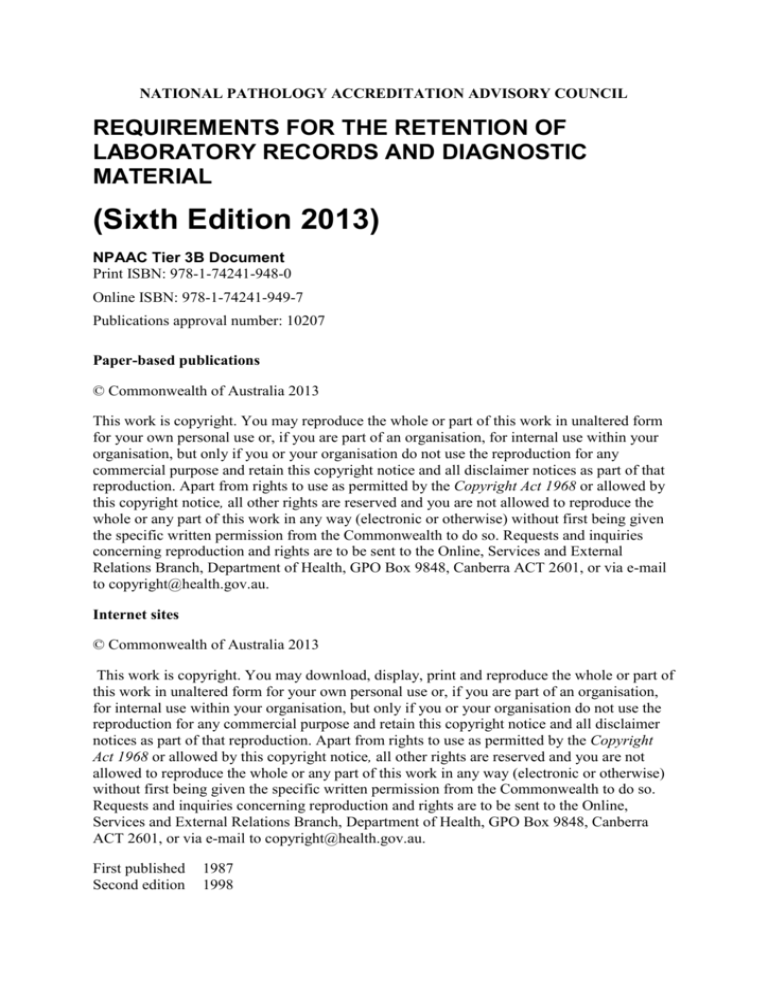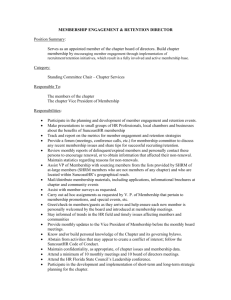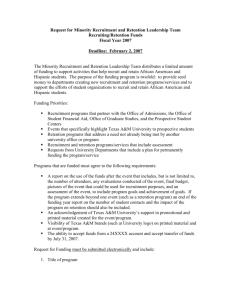
NATIONAL PATHOLOGY ACCREDITATION ADVISORY COUNCIL
REQUIREMENTS FOR THE RETENTION OF
LABORATORY RECORDS AND DIAGNOSTIC
MATERIAL
(Sixth Edition 2013)
NPAAC Tier 3B Document
Print ISBN: 978-1-74241-948-0
Online ISBN: 978-1-74241-949-7
Publications approval number: 10207
Paper-based publications
© Commonwealth of Australia 2013
This work is copyright. You may reproduce the whole or part of this work in unaltered form
for your own personal use or, if you are part of an organisation, for internal use within your
organisation, but only if you or your organisation do not use the reproduction for any
commercial purpose and retain this copyright notice and all disclaimer notices as part of that
reproduction. Apart from rights to use as permitted by the Copyright Act 1968 or allowed by
this copyright notice, all other rights are reserved and you are not allowed to reproduce the
whole or any part of this work in any way (electronic or otherwise) without first being given
the specific written permission from the Commonwealth to do so. Requests and inquiries
concerning reproduction and rights are to be sent to the Online, Services and External
Relations Branch, Department of Health, GPO Box 9848, Canberra ACT 2601, or via e-mail
to copyright@health.gov.au.
Internet sites
© Commonwealth of Australia 2013
This work is copyright. You may download, display, print and reproduce the whole or part of
this work in unaltered form for your own personal use or, if you are part of an organisation,
for internal use within your organisation, but only if you or your organisation do not use the
reproduction for any commercial purpose and retain this copyright notice and all disclaimer
notices as part of that reproduction. Apart from rights to use as permitted by the Copyright
Act 1968 or allowed by this copyright notice, all other rights are reserved and you are not
allowed to reproduce the whole or any part of this work in any way (electronic or otherwise)
without first being given the specific written permission from the Commonwealth to do so.
Requests and inquiries concerning reproduction and rights are to be sent to the Online,
Services and External Relations Branch, Department of Health, GPO Box 9848, Canberra
ACT 2601, or via e-mail to copyright@health.gov.au.
First published
Second edition
1987
1998
Third edition
Fourth edition
Fifth edition
Sixth edition
2002
2007 (formerly titled: Retention of Laboratory Records and Diagnostic
Material)
2009 reprinted with amendments
2013 reprinted and reformatted to be read in conjunction with the
Requirements for Medical Pathology Services
Australian Government Department of Health
Contents
Scope ........................................................................................................................................4
Abbreviations ...........................................................................................................................5
Definitions .................................................................................................................................5
Introduction ..............................................................................................................................5
Specific retention options for paediatric paraffin blocks, slides and reports .....................6
Returning a Specimen to a patient .........................................................................................7
Returning a body part .............................................................................................................7
Returning a processed Specimen ............................................................................................7
Impact of amalgamation, mergers or change of ownership .................................................8
Minimum retention times ........................................................................................................8
Discipline variations ..................................................................................................................8
Appendix A Notice of Information Technology (IT) Requirements under the
Electronic Transactions Act 1999 for scanning and storage of referrals and
requests (Normative) ............................................................................................................13
Appendix B State and territory legislation relating to the retention of
Laboratory records and diagnostic materials (Informative) ............................................14
Appendix C Recommended storage temperatures (Informative) .....................................15
Further information...............................................................................................................16
The National Pathology Accreditation Advisory Council (NPAAC) was established in 1979
to consider and make recommendations to the Australian, state and territory governments on
matters related to the accreditation of pathology laboratories and the introduction and
maintenance of uniform standards of practice in pathology laboratories throughout Australia.
A function of NPAAC is to formulate Standards and initiate and promote education programs
about pathology tests.
Publications produced by NPAAC are issued as accreditation material to provide guidance to
laboratories and accrediting agencies about minimum Standards considered acceptable for
good laboratory practice.
Failure to meet these minimum Standards may pose a risk to public health and patient safety.
Scope
The Requirements for the Retention of Laboratory Records and Diagnostic Material is a
Tier 3B NPAAC document and must be read in conjunction with the Tier 2 document
Requirements for Medical Pathology Services. The latter is the overarching document
broadly outlining standards for good medical pathology practice where the primary
consideration is patient welfare, and where the needs and expectations of patients, Laboratory
staff and referrers (both for pathology requests and inter-Laboratory referrals) are safely and
satisfactorily met in a timely manner.
Whilst there must be adherence to all the Requirements in the Tier 2 document, reference to
specific Standards in that document are provided for assistance under the headings in this
document.
The document Requirements for the Retention of Laboratory Records and Diagnostic
Material represents the minimum standards for retention of records and materials. Individual
Laboratories may choose to exceed these minimum requirements based on local
circumstances and historical practice.
Abbreviations
AS
ISO
NPAAC
TGA
Australian Standard
International Organization for Standardization
National Pathology Accreditation Advisory Council
Therapeutic Goods Administration
Definitions
Requirements for
Medical Pathology
Services (RMPS)
means the overarching document broadly outlining standards for
good medical pathology practice where the primary consideration
is patient welfare, and where the needs and expectations of
patients, Laboratory staff and referrers (both for pathology
requests and inter-Laboratory referrals) are safely and
satisfactorily met in a timely manner.
The standard headings are set out below –
Standard 1 – Ethical Practice
Standard 2 – Governance
Standard 3 – Quality Management
Standard 4 – Personnel
Standard 5 – Facilities and Equipment
A – Premises
B – Equipment
Standard 6 – Request-Test-Report Cycle
A – Pre-Analytical
B – Analytical
C – Post-Analytical
Standard 7 – Quality Assurance
Introduction
Pathology reports form part of the patient’s medical record, and may also be retained in, or
remain accessible from, the laboratory information system. In addition, Laboratories are
required to maintain a number of records which substantiate the validity of testing done for
the production of results for patient records.
Retaining Specimens has two primary purposes: to ensure there is a physical audit trail, in
case the integrity or identification of the Specimen needs to be established; and to allow
additional testing to be done on the original Specimen, if required. In some cases, the original
Specimen may be consumed, exhausted or be otherwise unsuitable for any additional testing;
however, retention is still required for audit and traceability purposes.
These Requirements are intended to serve as minimum Standards in the accreditation process
and have been developed with reference to current and proposed Australian regulations and
other standards from the International Organization for Standardization including:
AS ISO 15189 Medical laboratories – Requirements for quality and competence
These Requirements should be read within the national pathology accreditation framework in
conjunction with the current version of the following NPAAC document:
Tier 2 Document
Requirements for Medical Pathology Services
Please note that any Appendices attached to this document may be either normative or
informative and should be considered to be an integral part of this document.
The format of these Requirements currently remains substantially the same as the 5th Edition.
It is anticipated that the Requirements will be presented in a more standardised form
following the next document review.
The following information addresses specific areas relating to retention of Laboratory records
and diagnostic material and is reproduced from that document.
NPAAC uses terms such as ‘significant finding’ or ‘not clinically significant’, while
recognising that these terms can have different meanings to different people. The terms have
been retained in these Standards, without attempt at definition. Similarly, some
recommendations apply only if ‘appropriate’. Interpretation of these terms is left to the
professional judgement of the Laboratory supervisor, taking into account the intention and
context of the terms as they are used here.
Please note that all NPAAC documents can be accessed at NPAAC Publications.
While this document is for use in the accreditation process, comments from users would be
appreciated and can be directed to:
The Secretary
NPAAC Secretariat
Department of Health
GPO Box 9848 (MDP 951)
CANBERRA ACT 2601
Phone:
Fax:
Email:
Website:
+61 2 6289 4017
+61 2 6289 4028
NPAAC Email Address
DoHA Website
Specific retention options for paediatric paraffin blocks, slides and
reports
(Refer to Standard 1 in Requirements for Medical Pathology Services)
Earlier editions of these Standards proposed one retention time for adults and another for
children, until the child reached the age of 25 (i.e. age of majority [18 years], plus seven
years). In many cases, to comply with these Standards, all paraffin blocks, slides and reports
had to be retained for the extended period, even though this may have exceeded reasonable
requirements for non-paediatric paraffin blocks, slides and reports retention. The fourth
edition of the retention requirements proposed a reduction to 10 years for anatomical
pathology Specimens; however, note that the requirement for extended retention of paediatric
paraffin blocks, slides and associated reports was not waived. Laboratories now have the
option to devise a system to ensure that such paraffin blocks and slides are flagged at the time
they are created so they are retained for more than the default minimum of 10 years at the
time of disposal of non-retained Specimens.
Returning a Specimen to a patient
(Refer to Standard 1 in Requirements for Medical Pathology Services)
While a pathology practice may own the container in which a patient’s Specimen is held, in
most jurisdictions it does not legally own the Specimen itself.
The Laboratory must consider its duty of care to the patient before agreeing to release a
Specimen. This involves confirming the identity of the applicant and assessing the reason for
the applicant’s request for an early release or return of the Specimen, and using this
information to judge whether the request is reasonable. The Laboratory must be particularly
aware of the possibility of an unauthorised third party trying to obtain access to a patient’s
Specimens (e.g. for paternity testing or other litigation). In rare cases, the Laboratory may
wish to seek legal advice about an unusual request.
Returning a body part
(Refer to Standard 1 in Requirements for Medical Pathology Services)
A ‘body part’ may be a whole organ removed at autopsy or at surgery (e.g. kidney or uterus);
however, at present most requests are for the return of a ‘pre-viable fetus’* for burial or
cremation.
Jurisdictional regulations may constrain ownership of human tissue to prevent trading in
tissues and organs for transplantation. Infectious agents may be transmitted by tissues
(especially if unfixed), so the Laboratory must comply with relevant regulations, and must be
satisfied that the applicant will dispose of the fetus, organ or other body part lawfully and in a
way that meets community standards. The Laboratory must maintain appropriate records of
the return or disposal to the applicant of a fetus, organ or other body part, and must also
obtain a signed receipt from the applicant, which notes the above undertaking.
In some jurisdictions (e.g. New South Wales), where the application is made on behalf of an
Indigenous Australian, there is some legal extension of the concept of who can act as the
agent for the patient, or in the case of a deceased person, for the next-of-kin.
Returning a processed Specimen
(Refer to Standard 1 in Requirements for Medical Pathology Services)
*
A pre-viable fetus is a fetus that is too early in gestation for it to be classified as a stillbirth (for which a special
type of medical certificate of the cause of death must be issued). Such fetuses, under current definitions of a
stillbirth, are of less than 20 weeks gestational age; however, in practice, determining exact gestational age
between ~18 and ~22 weeks is difficult and generally done on the best available evidence from the features of
the fetus and any clinical information about the pregnancy.
The general principles outlined above for returning body parts also apply to returning
processed Specimens such as histopathology blocks or slides. However, because such
Specimens are processed tissues, the ‘ownership’ of the material is less clear. For this reason,
while a laboratory is free to follow the above guidelines relating to a body part, it may prefer
to be less flexible when responding to requests for returning processed Specimens for
unspecified purposes.
If the request for returning the material is to obtain a second opinion for a patient’s care, a
Laboratory will normally comply. The Laboratory may, however, require that the patient’s
consent be provided in writing, agreement that the Specimen is sent directly to the person
providing the second opinion, and that, unless specifically agreed otherwise, all of the
material is returned to the original Laboratory after the second opinion has been provided.
Impact of amalgamation, mergers or change of ownership
(Refer to Standard 2 in Requirements for Medical Pathology Services)
When health care organisations or pathology practices amalgamate or merge, those involved
must ensure that the integrity of both systems of documentation and record keeping is
maintained. Information from both systems must remain accessible.
The retention times for records and diagnostic materials outlined in this document must be
maintained regardless of changes of ownership or governance of the Laboratory. Similarly,
the retention times for records and diagnostic materials must be maintained regardless of
changes in information technology systems that result from such changes of ownership or
governance.
Health service providers are responsible for retaining or providing storage for health records
upon closure of their practice. Health service providers are also obliged to make health
information available to another health service provider at the request of a patient, or where
requested by an appropriately authorised health professional acting for, or on behalf of, the
patient. Current relevant state and territory legislative requirements must be implemented.
Minimum retention times
(Refer to Standard 6 in Requirements for Medical Pathology Services)
Discipline variations
While preparing this document, a common set of requirements for retention across all
disciplines was acknowledged as an ideal; however, there are valid practical reasons for some
discipline-to-discipline variations. Every effort has been made to minimise these and, where
they exist, ensure consistency of approach to comparable situations in the different
disciplines.
Table 1
1.1
1.2
1.3
1.4
1.5
1.6
1.7
Table 2
General minimum retention times†
Record/material
Personnel records
All quality control and quality assurance records
Equipment maintenance
Laboratory methods/procedures (manuals)
Referring doctor’s request, Laboratory records such
as records of analysis, calculations and observations
from which the result is derived
All Specimens, unless otherwise specified under the
separate disciplines given in the tables that follow
Minimum retention time
Period of employment + 3 years
3 years
Life of equipment + 3 years
3 years‡
3 years§
Copy of original report, or ability to reprint the
information content of an original report
7 years for adults
7 years from the age of majority for
minors**
7 days from date of receipt or until 2 days
after the date of the issued report
(whichever date is later), under
appropriate storage conditions and
reliable retrieval †
Minimum retention times for anatomical pathology
Please refer to Table 1 (General minimum retention times) for both record and material
retention times, unless otherwise specified below.
‡
The retention time of 3 years refers to the circumstance where a method/procedure/in-vitro diagnostic (IVD) device has been superseded
or replaced by a new and unrelated methodology. However, where a Laboratory method/procedure/IVD has simply been modified, the full
history of all earlier versions/modifications of that particular IVD must continue to be retained.
§
Storage of scanned facsimile images and associated records of these intermediary documents is a satisfactory alternative to retention of the
original document. For those areas where material is retained for longer than 3 years, the Laboratory may wish to consider retaining the
associated records for a corresponding period. See also Appendices A & B for electronic storage requirements of pathology request forms.
†Appendix C is a guide to suggested storage temperatures.
**
Where the report pertains to a Specimen collected from a paediatric patient, see page 3 indicating retention until the person reaches the
age of 25, except for genetics, where the retention time is 100 years.
Record/material
2.1
Minimum retention time
Slides:
Sections of fixed tissue preserved in mounting
medium
10 years††
Sections of unfixed tissue not in permanent
mounting medium (including
immunofluorescence slides)
See General 1.6
2.2
Blocks of tissue embedded in paraffin wax or any
other permanent embedding medium
10 years††‡‡
2.3
Specimens for intra-operative frozen section
diagnosis:
10 years8
(i) The original section(s) used for diagnosis,
preserved in permanent mounting medium
(ii) Residual tissue from which the sections in (i)
were prepared, embedded in paraffin
2.4
2.5
2.6
2.7
Table 3
(iii) All other blocks of paraffin-embedded tissue
from the same Specimen or Specimens from
which tissue has been selected for frozen section
examination
Frozen tissue blocks, including Specimen for
immunofluorescence studies
(i) Containers with no residual tissue
1 month at -70°C or lower
1 month
(ii) Unblocked tissue from Specimens removed at
surgery
1 month from date of issue of Specimen report
(iii) Unblocked tissue from Specimens retained at
autopsy
3 months after autopsy unless a limitation is
imposed, such as the need to reunite retained
Specimens with the body before a funeral has
been stipulated by next-of-kin
10 years for autopsy other than forensic or other
medico-legal autopsy
In accordance with jurisdiction requirement or 20
years if not specified
Autopsy — registers, report duplicate, blocks and
slides, records of tissue and organ disposal
Forensic and medico-legal
Minimum retention times for chemical pathology
Please refer to Table 1 (General minimum retention times) for both record and material
retention times, unless otherwise specified below.
††
Where the report pertains to a Specimen collected from a paediatric patient, see page 2 indicating retention until the person reaches the
age of 25, except for genetics, where the retention time is 100 years.
‡‡
Where the report pertains to a Specimen collected from a paediatric patient, see page 2 indicating retention until the person reaches the
age of 25, except for genetics, where the retention time is 100 years.
3.1
Table 4
Record/material
Serum, plasma, other body fluid and tissue Specimens
Minimum retention time
See General 1.6
Minimum retention times for cytology
Please refer to Table 1 (General minimum retention times) for both record and material
retention times, unless otherwise specified below.
4.1
4.2
4.3
4.4
Record/material
Exfoliative cytology and fine needle aspirations (FNAs)
including slides and cell blocks
Gynaecological (cervical) cytology slides
Specimens of sputum, urine and other body fluids
Specimens received in liquid-based fixative
Minimum retention time
10 years
10 years
See General 1.6
1 month
Table 5
Minimum retention times for genetics (including biochemical genetics,
cytogenetics, molecular genetics and newborn screening)
Please refer to Table 1 (General minimum retention times) for both record and material
retention times, unless otherwise specified below.
5.1
5.2
5.3
5.4
5.5
5.6
Record/material
Copy of original report, or ability to reprint the
information content of an original report
Cytogenetics:
Analysis records/karyotypes
Microscope slides
Cytogenetics/molecular genetics:
Fixed chromosome cell suspension
Cytogenetics/molecular genetics:
Original Specimens and containers
Cytogenetics/biochemical genetics/molecular
genetics:
Tissue cultures/cell culture lines
Biochemical genetics:
Specimens of plasma, serum and urine
5.7
Molecular genetics:
DNA extracts for molecular genetics
5.8
Neonatal screening (dried blood spot)
Cards
Table 6
Minimum retention times
100 years (effectively indefinite)
3 years
3 years
6 months
1 month from date of issue of report
Clinically significant: for cryopreservation
Not clinically significant: as for General 1.6
Original container: 7 days
An aliquot: 3 months after date of issue of
report
3 months from date of issue of the report for
an individual or for completion of a family
study or for completion of testing;
whichever of the three periods is the longest
Specimens: a minimum of 2 years
Records: see Genetics 5.1
Minimum retention times for haematology
Please refer to Table 1 (General minimum retention times) for both record and material
retention times, unless otherwise specified below.
6.1
Record/material
Blood films
6.2
6.3
Plasma for special haemostasis testing
Blood Specimens, other than 6.1–6.2
6.4
Bone marrow — slides and reports
Table 7
Minimum retention time
Clinically significant: 1 year
Not clinically significant: 1 month
3 months at -20oC or lower
As for General 1.6 for purpose of
identification and traceability, noting that
repeat testing may not be technically
reliable after 2 days
10 years
Minimum retention times for immunohaematology (blood transfusion)
Please refer to Table 1 (General minimum retention times) for both record and material
retention times, unless otherwise specified below.
7.1
Table 8
Record/material
Laboratory records of blood products received and issued
Minimum retention time
20 years
Minimum retention times for immunology
Please refer to Table 1 (General minimum retention times) for both record and material
retention times, unless otherwise specified below.
8.1
8.2
8.3
Table 9
Record/material
Serum, plasma, other body fluid and tissue Specimens
Frozen tissue blocks, including Specimens for
immunofluorescence studies
Immunofluorescence slides
Minimum retention time
See General 1.6
1 month at -70oC or lower
See General 1.6
Minimum retention times for microbiology
Please refer to Table 1 (General minimum retention times) for both record and material
retention times, unless otherwise specified below.
9.1
Record/material
Slides
9.2
Isolates
9.3
Serum/plasma for infectious disease
serology
9.4
Urine Specimen for microbiological
examination
Minimum retention times
Wet preparations: discard
Immunofluorescence slides: 7 days
Gram stains: 2 weeks
Ziehl-Neelsen stains: 6 weeks
Other stained slides: 2 weeks
Clinically significant: 5 days
Not clinically significant: discard
All sera (unless specified below): 4 months
Antenatal sera: 12 months
Syphilis (reactive): 12 months
3 days from date of receipt: under refrigeration
Table 10 Minimum retention times for other material
Please refer to Table 1 (General minimum retention times) for both record and material
retention times, unless otherwise specified below.
10.1
Record/material
Semen for fertility analysis
10.2
Cell therapy
Minimum retention times
2-3 days from date of receipt for purpose of
identification and traceability noting that repeat
testing may not be technically reliable after 1 day.
Refer to relevant TGA regulations and NPAAC
Requirements that may be applicable
Appendix A
Notice of Information Technology (IT)
Requirements under the Electronic Transactions Act 1999 for
scanning and storage of referrals and requests
(Normative)
1. Authority
1.1 This Notice is made pursuant to sections 9, 10, 11 and 12 of the Electronic Transactions Act
1999.
2. Scope
2.1 This Notice specifies Medicare Australia’s information technology requirements (Medicare
Australia’s IT requirements) for electronic scanning and storage of certain referrals and
requests1.
3. Date of Effect
3.1 1 October 2009.
4. Replaces
4.1 This Notice replaces the Notice of Information Technology (IT) Standards under the
Electronic Transactions Act 1999 for Electronic and Paper:
Referrals to Consultant Physicians or specialists
Requests and Confirmations of Requests for Pathology Services to Approved Pathology
Practitioners
Requests for Diagnostic Imaging Services
which is repealed with effect from 30 September 2009.
5. Definitions
5.1 A ‘request’ means any request for diagnostic imaging or pathology Medicare Benefits
Schedule items. Any reference to a ‘request’ for a Medical Pathology Service includes a
confirmation of that request.
1 The
term ‘request’ includes ‘combined requests and assignments’.
5.2 A ‘referral’ means any referral for Medicare Benefits Schedule claimable items.
6. Scanning of paper referrals or requests for electronic storage
6.1 Clause 6 applies where a referral or request is required to be given to, or can be requested by,
Medicare Australia and an image of a paper referral or request is scanned for electronic
storage.
6.2 The scanning and storage system must ensure that:
(a) the scanned image is unaltered and unalterable from the moment scanning is finished;
(b) the date and time the image was converted to digital form be recorded; and
(c) the image be retrievable in a legible form.
7. Storage of electronically transmitted referrals or requests
7.1 Clause 7 applies where a referral or request is required to be given to, or can be requested by,
Medicare Australia and the referral or request has been electronically transmitted and stored.
7.2 The storage system must ensure that:
(a) the stored electronic transmission is unaltered and unalterable;
(b) the date and time the electronic transmission was received be recorded; and
(c) the stored electronic transmission be retrievable in a legible form.
8. Security and access
8.1 A system that electronically stores referrals or requests, whether scanned or electronically
transmitted, must provide reasonable measures to prevent any loss, improper disclosure or
destruction of the stored information.
Appendix B State and territory legislation relating to the retention
of Laboratory records and diagnostic materials (Informative)
This table is intended to assist Laboratories by consolidating reference to various relevant legislations that may
affect retention requirements. The references in this table, while extensive, are not intended to be exhaustive. In
some cases, the relevant jurisdictional legislation may take precedence over these requirements in terms of
mandating retention times different from those specified in these requirements. The content of the table was
correct at the time of preparation; changes may be implemented by states and territories in the future that may
affect the legislative requirements.
State
New South Wales
Queensland
Northern Territory
Australian Capital
Territory
Victoria
South Australia
Western Australia
Tasmania
Legislation
Medical Practice Regulation 1998
Private Hospital Regulation 1996
Public Hospital Regulation 1996
State Records Act 1998
Circular 96/88 Retention of Medical Records
Human Tissue Act 1983
Queensland Health (Pathology Laboratory Records) Retention and Disposal
Schedule
Coroner’s Act 2003
Transplantation and Anatomy Act 1979
Queensland Public Records Act 2002
There is no current relevant legislation in place specifically for pathology results
and Specimens. A general disposal schedule for medical records is currently in
draft form.
Health Records (Privacy and Access) Act 1997
Public Health Act 1997
Medical Practitioners Act 1930
Medical Treatment Act 1994
Health Act 1933
Health Services Act 1988
Medical Practice Act 1994
Public Records Act 1973
Freedom of Information Act 1991
Health Act 1935
South Australian Health Commission Act 1976
State Record Act 1997
Transplantation and Anatomy Act 1983
Patient Information Retention and Disposal Schedule v2 2000
State Records Act 2000
Medical Practitioners Registration Act 1996
Anatomy Act 1964
Health Act 1997
Hospitals Act 1918
Human Tissue Act 1985
Public Health Act 1997
Appendix C Recommended storage temperatures (Informative)
Type of storage
Temperature
Immunohaematology
Storage of blood and blood products
See AS 3864 Medical refrigeration equipment –
For the storage of blood and blood products
Standards Australia
General
Refrigeration
2-8°C
Freezer
-20°C or lower
Deep freezer
-70°C or lower
Note 1: Laboratories may choose to use temperature ranges other than the above recommendations for
Specimen storage. In such cases, the use of ranges other than the above must be supported by
Laboratory documentation and (where appropriate) validation.
Note 2: Use of Specimen refrigerators/freezers for storage of other products (e.g. reagents) requires
that consideration must be given the storage requirements of these other products stored with
the Specimens.
Note 3: Use of Specimen refrigerators/freezers for storage of food/drink is not permitted, for reasons
of occupational and environmental health and safety.
Note 4: Use of Specimen refrigerators/freezers for storage of tissue Specimens intended for
transplantation or use as a therapeutic device requires that the Laboratory complies with the
regulatory requirements of TGA and other relevant regulatory codes.
Note 5: Some types of refrigerator/freezer involve “freeze/thaw” cycles as part of their auto-defrost
features. Specimens stored in these types of refrigerators/freezers should not be intended for
later testing of analytes that are degraded by such freeze/thaw cycles.
Further information
Other NPAAC documents are available from:
NPAAC Secretariat
Primary Care, Diagnostics & Radiation Oncology Branch
Department of Health
GPO Box 9848 (MDP 951)
CANBERRA ACT 2601
Phone:
Fax:
Email:
Website:
+61 2 6289 4017
+61 2 6289 4028
NPAAC Email Address
DoHA Website







